Tired of shoveling snow by hand? You should buy yourself a good snowblower from my review list. It will make your life easier!
A snow blower is an awesome machine that will remove snow from your driveway with hardly any effort. You can use it to clear your sidewalk and porch too!
But how does it do it? How does a snow blower work?
Understanding how a snow blower works will help you get a better idea of what to expect from your machine and how to use it safely and effectively.
I will explain in detail how snow blowers operate and help you pick the best type for your yard. You can find lots more below!
Contents
Everything You Need To Know About Snow Blowers
What Is A Snow Blower?
A snow blower is a powered machine designed to pick up the snow from the ground and throw it to the side. The rotating auger pushes snow directly through the discharge chute or indirectly with the help of an impeller.
Snowblowers are used for clearing snow from paved and unpaved surfaces, such as driveways, sidewalks, and pathways.
There are three types of snow blowers:
- Single-stage snow blowers
- Two-stage snow blower
Three-stage snow blowers process snow in three stages. They have the same operation as two-stage machines, with the addition of the induction accelerator.
The accelerator speeds up the process. It breaks up dense snow and feeds it into the impeller, making it go through the impeller faster. In fact, an accelerator makes a three-stage snow blower roughly 50 percent faster than a two-stage snowblower.
Snow blowers can be also grouped based on their power source. You can buy a gas-powered, electric corded, or battery-powered unit. Each type has its own advantages and disadvantages.
How Does A Snow Blower Work?
All snow blowers have the same basic operation. They scoop up the snow from the ground with an auger and discharge it through the snow chute, with or without the help of the impeller.
But this is a simplified explanation of how a snow blower works. Let’s look at the details!
Starting The Engine
All snow blowers have an internal gas engine or electric motor that powers the whole operation. The engine of the snowblower is either started by a recoil start or a push-button electric start.
Smaller units with 2-cycle engines usually only have a recoil start. Bigger and stronger snow blowers with 4-cycle engines have both options on hand.
If you are having trouble starting your snowblower after sitting, I recommend you read and follow my troubleshooting steps.
Watch this video to learn how to use electric start:
Engaging The Auger
The engine crankshaft that extends out of the engine is attached to one or more drive pulleys. A single-stage snow blower will have only one spring-loaded idler pulley and drive belt that engage the auger.
Two-stage snow blowers will have multiple drive pulleys and belts to drive auger, impeller, and self-propelled wheels.
This video shows how pulleys and drive belts put a snowblower in motion:
More About The Auger
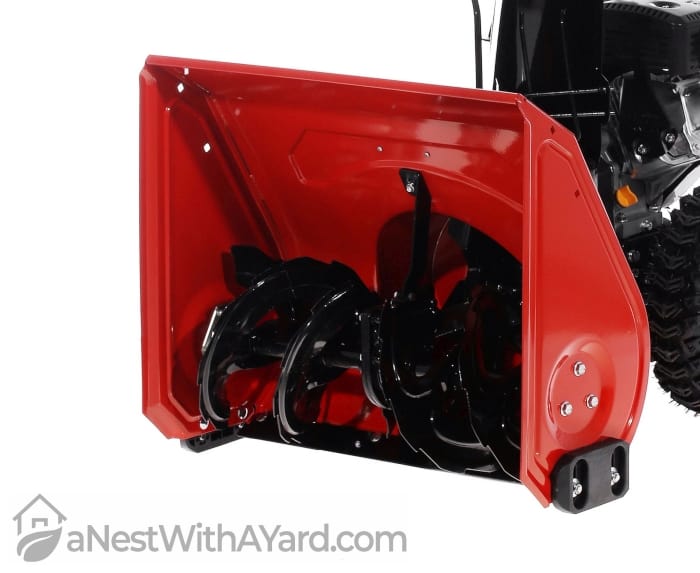
No matter the size, all snow blowers share one thing – an auger! An auger is a set of rotating blades located inside the intake housing. An auger can be made from plastic, steel, aluminum, or other materials.
Small snow throwers and snow shovels, meant for clearing light snow, typically have a plastic auger. It keeps the machine lightweight and portable.
Two-stage and three-stage snow blowers are designed for cleaning compacted and heavy snow. That is why they are usually equipped with a steel auger.
When you go shopping for a snowblower, you will notice that augers have different shapes. They are most commonly in helix shape. Here, the blades are placed horizontally and run across the bar in the helix pattern. Some machines have a corkscrew design, and others have independent blades.
Speaking of blades, they can be either exposed or covered by a protective rubber.
Single-stage snow blowers usually have rubber-coated blades on the auger because they scrape the ground. The rubber keeps the blades from damaging the driveway. Two and three-stage snow blowers have fully or partly exposed blades. This feature allows them to cut through heavy snow better and faster.
Augers don’t only defer in the design but also the size. Here’s what you need to know:
- Length of the auger
The length of the auger determines the clearing width. Clearing width tells you how wide of a path a snowblower makes in one pass. The longer the auger, the wider path it will clear, the quicker you will be done clearing your driveway.
- Diameter of the auger
The diameter of the auger sets the cutting depth. The cutting depth is roughly half the diameter because only the bottom half of the auger is in contact with the snow. For instance, an auger with a diameter of 12 inches will cut 6 inches deep into the snow.
Don’t know what size snow blower you need? Find out here!
Discharge
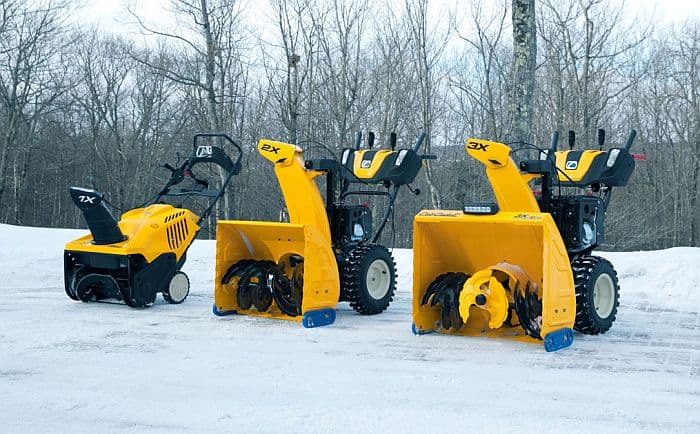
Once the auger picks up the snow, it either immediately directs it through the discharge chute or feeds it to the impeller. The discharge process depends on how many stages the snow blower has.
Let’s see how discharge looks in single, two, and three-stage machines:
- Discharge of a single-stage snow blower
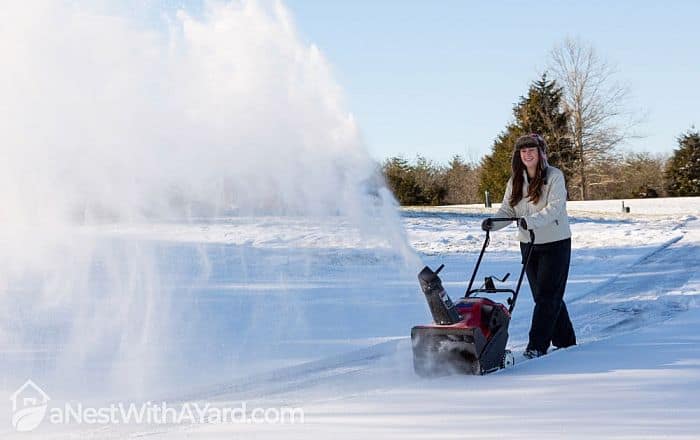
A single-stage snow blower uses an auger to pick up the snow and shoot it through the chute. A single-stage snow blower doesn’t have any special component in the design that is responsible for throwing the snow. The auger does it all!
A fast-rotating auger creates enough momentum to shoot the snow 10 to 20 ft away, depending on the unit. But they can’t throw snow as far as two and three-stage models.
The auger of a single-stage snow blower scrapes against the ground and leaves very little snow behind. That’s a big plus. But, since single-stage snow blowers clear close to the ground, they can’t be used on gravel driveways. If you use it, you will shoot stones in the air, and put yourself and others in danger.
Because of their limited strength and capacity, single-stage snow blowers perform best on light snow. If you use a single-stage blower on heavy snow, you will end up clogging the discharge or breaking the machine.
- Discharge of a two-stage snow blower
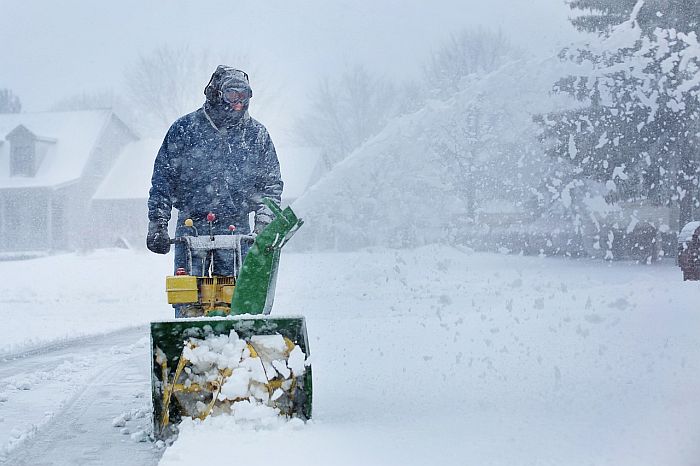
In addition to the auger, two-stage snow blowers have an impeller too! An impeller is responsible for blowing the snow through the discharge chute, not the auger. It rotates at a high speed and blows the snow up to 60 feet away.
Two-stage snow blowers can process more snow because of the quick discharge and bigger auger. They can clear wet and heavy snow without major hiccups. We talk more about it in this article.
Two-stage snow blowers don’t clear as close to the ground as single-stage units. They typically leave a thin layer of snow behind. You can adjust the skid shoes and lower the intake housing to minimize the trace.
Because the auger doesn’t scrape against the ground, you can use your two-stage snow blower on gravel.
- Discharge of a three-stage snow blower
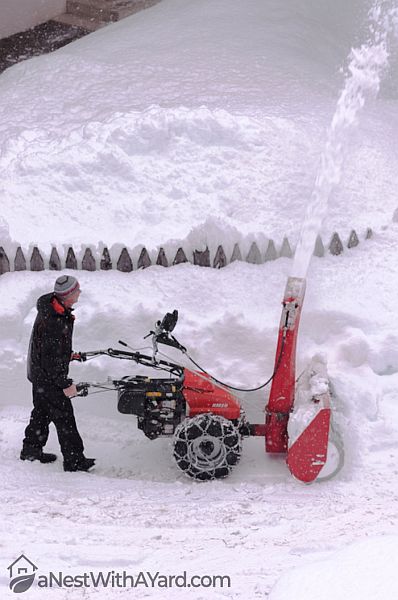
A three-stage snow blower also uses an impeller to blow snow to the side. The process is, however, slightly different.
The snow is first picked up by two augers! These heavy-duty augers direct the snow towards the center of the machine, where the induction accelerator is located.
The induction accelerator breaks ice and heavy snow into smaller pieces that are palatable to the impeller. The accelerator feeds the shredded snow to the impeller that can now easily blow it as far as 50 ft away.
The augers only have one role – picking up the snow. They no longer have to break it up or even throw it to the side. The augers do their job very well. They remove all the snow from the ground, leaving nothing behind.
Three-stage snow blowers are the best machines for snow removal. They can handle any type of snow. They clear snow faster too! A three-stage snow blower can move up to 50 percent more snow than its smaller cousin.
You can find a whole comparison of 2-stage vs 3-stage snow blowers here.
How A Snow Blower Moves
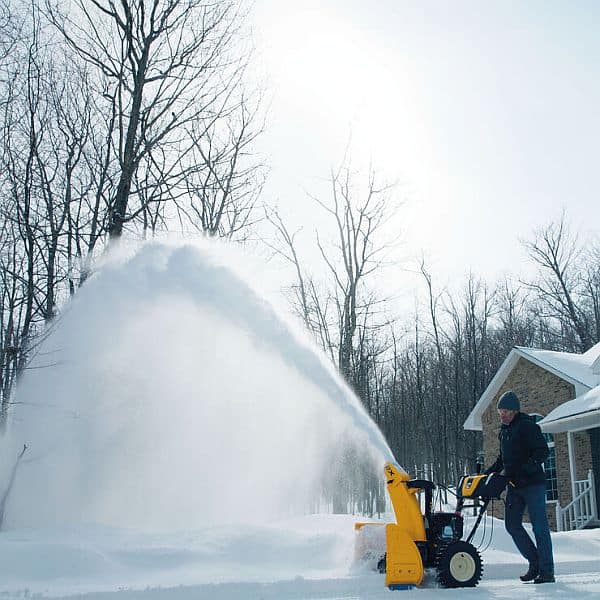
Single-stage snow blowers are smaller in size and weigh less than two and three-stage machines. They can be pushed without the assistance of a self-propelled mechanism.
The auger on a single-stage snow blower helps the user move the machine forward. I have already mentioned that the auger on single-stage units scrapes the ground. It almost paddles the machine forward, once you push it.
That’s why single-stage machines are usually not self-propelled. They are so light, they don’t need to be!
Two and three-stage snow blowers are much bigger and weigh a ton. Most two-stage snowblowers sold today are self-propelled. Three-stage snow blowers are always self-propelled.
Self-propelled transmission assists the user in moving the machine forward. Snowblowers that have this feature also have forward and reverse speeds for an optimal working experience.
Self-propelled snow blowers are also equipped with power steering aka power assist steering. This feature helps the user make turns in harsh winter conditions when the blower is moving forward with great momentum. Power steering helps you steer the snowblower through deep snow with confidence.
FAQs
What does a snow blower do?
A snow blower removes snow from one area and relocates it to another. It picks snow off the ground and discharges it to the side. It clears snow off driveways, sidewalks, pathways, porches, and other places where clearance is needed.
Do snow blowers work on ice?
Snow blowers work on ice if they are powerful, large, and heavy enough. How well a snowblower works on ice also depends on the thickness of the ice. Two and three-stage machines are better equipped for breaking and removing the ice.
What does a snow blower run on?
A snowblower runs on gasoline if it has a gas engine. Most users find 87 octane fuel good enough. You can use any gasoline, as long as it doesn’t contain more than 10 percent ethanol. They can also be powered by electricity via an electric cord or a rechargeable battery.
Is electric start snow blower worth it?
An electric start snow blower is worth it if it has a 4-cycle engine. Starting a small snow thrower with a 2-cycle engine only takes a few pulls, but firing up a bigger blower is much harder without an electric start. Electric start makes starting any blower a breeze.
Now You Know How A Snow Blower Works
You no longer have to ask yourself: How does a snow blower work? Now you know exactly how!
A snow blower is a pretty straightforward machine with a tried and proven mechanism. Its operation starts with the auger and ends at the discharge chute. The process can be as simple as that, or it can include one or two more stages.
Now that you know the ins and outs of your snow blower, you can use it safely and effectively and to its fullest potential this winter!
What do you think? Feel free to ask any questions in the comments and share your thoughts. I would love to hear from you!


Would it be possible to use a snow blower to redirect the picked up snow to some location near the machine — say 5 feet away — creating a long pile of snow next to the cleared area (rather than blow it far away in a scattered manner)?